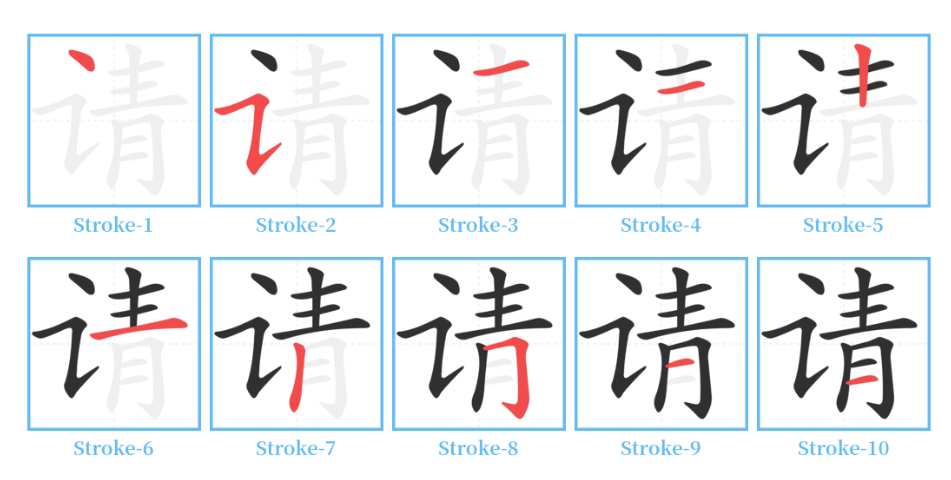How to Say Please in Chinese: Polite Phrases and Cultural Tips
In many languages, please is the basis of polite communication. For Chinese learners, understanding how to say please in Chinese is not only a way of expressing politeness, but also a step towards mastering the cultural nuances of the language. Unlike English, please in Chinese language has its own unique rules and contexts of use, which can sometimes be confusing for Chinese beginners.
In this article, we will explore the meaning of please in Chinese, how to pronounce please in Chinese Mandarin accurately, how to write please in Chinese letters etc. It will help you master the polite word “please” and understand its role in Chinese culture!

How Do You Say Please in Chinese?
The Chinese character for “please” is literally translated as “请” (qǐng), it’s a universal and commonly used word that plays an important role in polite language. Not only does it show respect, but using this word also makes you sound more natural and polite in various social situations.
Pronunciation and Chinese Pinyin for Please in Mandarin
The word “请” is pronounced as “qǐng”, where the “q” is the soft “ch” (similar to the “cheap” in “ch”, but with a more forward tongue position). This sound is the third tone, starting from the middle tone, gradually decreasing, and then increasing. Correct pronunciation:
- When you say “请 qǐng”, the tone is slightly lowered and then raised.
- Practice with Chinese pinyin: qǐng (third tone).
When learning Chinese, it is crucial to get the tones correct because a change in tone can completely change the meaning of a word. For example, pronouncing qǐng as qīng (first tone) can confuse meaning.
Examples of the use of please in Chinese
Here are some commonly used Chinese phrases. “请” (qǐng) is generally used for polite requests or invitations:
- 请进 (qǐng jìn) – “Please come in.”
Often used to welcome someone into a space, such as a home or office.
- 请坐 (qǐng zuò) – “Please sit down.”
A polite expression for asking someone to take a seat is often used on formal or professional occasions.
- 请问 (qǐng wèn) – “Excuse me, may I ask…?”
This phrase is often used to ask for information and is a polite way to start a question.
These examples illustrate how please can be combined with other words to form polite phrases in everyday Chinese dialogue.
How to Write Please in Chinese Characters?
The Chinese character 请 (qǐng) is not only important for spoken Chinese communication, but it is also vital for learners who wish to read and write Chinese effectively.
Breaking the Chinese character down into parts and understanding its structure will make the writing process much easier. Here are some step-by-step guides to help you master the character ‘请’:
Breaking Down the Character “请”
- Radical (部首): 讠 (yán zì páng)
The radical 讠 (derived from 言, meaning “speech”) is located on the left side of a Chinese character. It indicates that the word is related to speech, communication, or request.Identifying radicals is essential to understanding and memorizing Chinese characters, as they often hint at the meaning of the word.
- Number of Strokes: 10 Strokes
The character “请” has a total of 10 strokes. Each stroke must be written in the correct order to ensure the correct shape of the character.
- Meaning:
The main meaning of the word “请” is “request” or “invite”. It indicates politeness and is often used to moderate the tone of a sentence.
Stroke order for writing “请”
When writing the character “请”, please follow the standard stroke order rules used in Chinese calligraphy. This will ensure that the character is clear and beautiful. Here are the stroke order steps:
- Start with the radical 讠:
First, write the short oblique strokes (丶).Then write the vertical stroke with a hook (亅).
- Move to the right side of the character:
Write the horizontal stroke (一).Add the short vertical stroke (丨) that intersects the horizontal stroke.Complete the box shape with the bottom horizontal stroke and close the top part (口).Add the final strokes below: the vertical stroke (丨), the diagonal stroke (丿), and finally add the final horizontal stroke (一).
By practicing these steps, you will soon recognize the correct writing structure of the character ‘请’.

Tips for Writing Chinese Character
1.Follow the rules of stroke order:
Chinese characters have a specific stroke order, usually starting at the top left and going to the bottom right. Following these rules will ensure that your writing is natural and legible.
2.Practice writing consistently:
Repetition is the key to learning Chinese characters. You can write the character ‘please’ several times until you feel familiar with its structure and stroke order.
3.Use digital tools to aid learning:
Chinese online courses or learning apps can help you learn and practice writing Chinese characters more conveniently.
Different Ways to Express Please in Chinese Language
Although ‘请’ is the most common and direct expression of please in Mandarin Chinese, there are other ways to express it in different specific situations. Understanding the different ways to say please in Chinese will help you communicate more naturally and appropriately.
Flexible ways to say please in Chinese
1.麻烦你 (máfan nǐ) – “Could you please…”
- Meaning and usage:
This phrase gives a sense of courtesy and is often used to ask someone to do something that may require effort. It is softer than using “please” directly and is suitable for semi-formal or casual occasions.
- Examples:
麻烦你帮我拿一下。(Máfan nǐ bāng wǒ ná yīxià.) – “Could you please help me carry this?”麻烦你告诉我怎么去火车站。(Máfan nǐ gàosu wǒ zěnme qù huǒchēzhàn.) – “Could you please tell me how to get to the train station?”
2.劳驾 (láo jià) – “Excuse me, please…”
- Meaning and usage:
This polite expression is used to get someone’s attention or to ask for help in public. It is slightly more formal than “Could you please…” and is often used with strangers or in professional settings.
- Examples:
劳驾,请问最近的地铁站在哪里? (Láo jià, qǐng wèn zuìjìn de dìtiě zhàn zài nǎlǐ?) – “Excuse me, could you please tell me where the nearest subway station is?”劳驾,您能帮我挪一下车吗? (Láo jià, nín néng bāng wǒ nuó yīxià chē ma?) – “Excuse me, could you please move your car?”
The Different Meanings of Please in Chinese: Beyond Politeness
1.(使)开心;(使)满意;取悦 (shǐ ) kāi xīn; ( shǐ ) mǎn yì qǔ yuè
To make someone feel happy or satisfied, or to give someone pleasure.
- I only got married to please my parents.
我结婚只是为了让我父母高兴。(wǒ jié hūn zhǐ shì wèi le ràng wǒ fù mǔ gāo xìng.)
- He was always a good boy, very friendly and eager to please.
他一直是个好孩子,对人非常友好,容易相处。(tā yī zhí shì gè hǎo hái zi , duì rén fēi cháng yǒu hǎo , róng yì xiāng chǔ.)
- It always pleases me to see a well-designed book!
看到一本设计精美的书,我总是很开心。(kàn dào yī běn shè jì jīng měi dí shū , wǒ zǒng shì hěn kāi xīn.)
2.愿意;乐意 (yuàn yì; lè yì)
To want, like, or choose, when used with words such as “whatever”, “whoever”, and “anywhere”.
- She thinks she can just do whatever/as she pleases.
她觉得自己可以为所欲为。(tā jué de zì jǐ kě yǐ wéi suǒ yù wéi.)
- I shall go out with whoever I please.
我想和谁出去就和谁出去。(wǒ xiǎng hé shuí chū qù jiù hé shuí chū qù.)
The Cultural Significance of Saying Please in Chinese
In Chinese culture, politeness plays an important role in communication, but the way it is expressed is very different from English. Although “请” is the key word for please in Chinese, it is not used as frequently as please in English, especially in informal or intimate situations. Instead, Chinese speakers usually rely on tone, context and non-verbal cues to express respect and politeness.
For example, between family members or close friends, the use of “请” can sometimes feel overly formal or distant. When this happens, the request is usually softened by the tone or wording of the request, rather than explicitly saying please.
On the other hand, in formal situations, such as addressing a stranger, colleague, or authority figure, the use of “请” or similar polite phrases is essential to show respect and maintain proper etiquette.

Frequently Asked Questions
1. Why Saying Please in Chinese is Different from English?
Chinese relies on context, tone, and relationship to express politeness; whereas in English, please is almost ubiquitous in polite language and is often used regardless of relationship.
For example, you might say ‘please’ when asking a family member to help you pass something or when making a formal request in the workplace. In Chinese, however, the use of ‘please’ or other polite phrases is more selective and depends largely on the situation.
This cultural nuance reflects the collectivist nature of Chinese society, in which relationships and shared understanding often take precedence over explicit verbal expressions of politeness.
2. Is please necessary in daily Chinese communication?
A common mistake made by Chinese beginners is to translate requests from their native language into Chinese. Such sentences are usually grammatically correct, but they sound unnatural or overly polite for native Chinese speakers. You will rarely use please in your daily life.
For example: You are at a noodle shop and want to order a bowl of beef noodles. The first thing you might think to say is: “请你给我一份牛肉面” (qǐng nǐ gěi wǒ yīfēn niú ròu miàn), since it is an English level of politeness. However, the Chinese people don’t say that. Instead, they just say 一份牛肉面 (a bowl of beef noodles). It sounds rude, but it is natural in Chinese.
In short, please is not necessary when you are talking to a waiter or some customer service person. But if you are willing to say please, there is nothing wrong with that.
Summary
If you are interested in learning Chinese but feel that everything seems too cumbersome? Then with WuKong Chinese, we can help you understand basic Chinese grammar concepts and important vocabulary as well as other aspects of Chinese learning. So join us now to learn Chinese together!
Learn authentic Chinese from those who live and breathe the culture.
Specially tailored for kids aged 3-18 around the world!
Get started free!Master’s degree from Yangzhou University. Possessing 10 years of experience in K-12 Chinese language teaching and research, with over 10 published papers in teh field of language and literature. Currently responsible for teh research and production of “WuKong Chinese” major courses, particularly focusing on teh course’s interest, expansiveness, and its impact on students’ thinking development. She also dedicated to helping children acquire a stronger foundation in Chinese language learning, including Chinese characters, phonetics (pinyin), vocabulary, idioms, classic stories, and Chinese culture. Our Chinese language courses for academic advancement aim to provide children with a wealth of noledge and a deeper understanding of Chinese language skills.




![Math League: Competitions, Challenges, and Achievements [2025 Full Guide] Math League: Competitions, Challenges, and Achievements [2025 Full Guide]](https://wp-more.wukongedu.net/blog/wp-content/uploads/2024/01/school-2353406-520x293.jpg)


![2025 Guide for Math Kangaroo USA [With Free Past Papers PDF] 2025 Guide for Math Kangaroo USA [With Free Past Papers PDF]](https://wp-more.wukongedu.net/blog/wp-content/uploads/2023/10/screenshot-20231024-151438-520x293.png)



Comments0
Comments